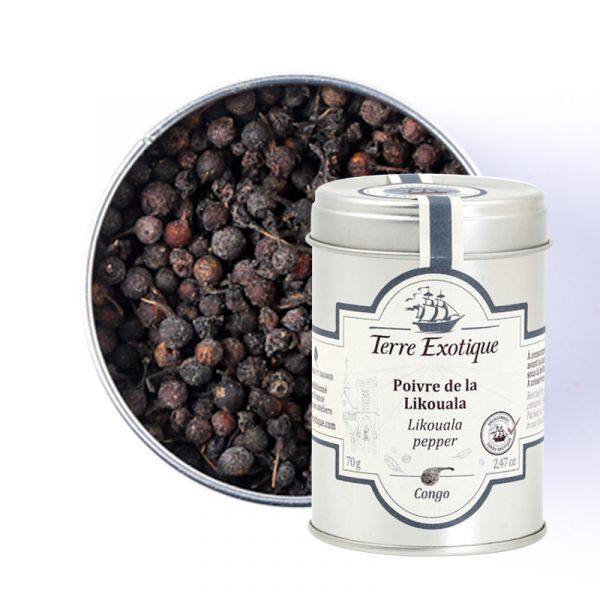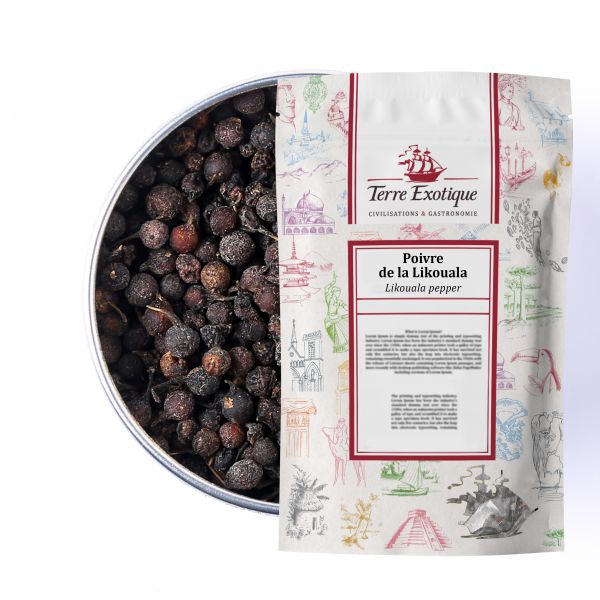



When to use Likouala
pepper
How to use Likouala pepper
Try out our recipe
ideas:
This delicately
aromatic pepper with initial spicy notes and its mild bite, is perfect either
whole or ground in stew type dishes as it withstands long cooking times. Its
flavour develops deliciously with olive oil, and its aromas will enhance the
flavours of seared or flash fried meat.
·
Chicken in white wine sauce with walnuts,
goat’s cheese and Likouala pepper: mix the chunks of goat’s cheese and gingerbread
together then add the chopped walnuts and chervil. Season with freshly ground Likouala pepper and
salt (see the full recipe below);
·
Roast root vegetables: crack roughly 1 teaspoon of
Likouala pepper over your vegetables before roasting;
·
Steak tartare: crack 5 peppercorns of Likouala
pepper in a pestle and mortar and sprinkle over your steak before serving;
·
Soft fruit clafoutis: crack 2 teaspoons of Likouala
pepper in a pestle and mortar and add to the clafoutis mixture before baking.
Chicken in white wine sauce with walnuts, goat’s cheese and Likouala pepper
Ingredients for 4 people
For the vegetables:
4 black radishes;
1 lemon (juice);
10g butter;
1 teaspoon sugar.
For the stuffed
chicken breasts:
60g goat’s cheese;
30g gingerbread;
10g chervil;
30g walnuts;
4 chicken breasts (150g);
10g butter.
For the wine sauce:
1 shallot;
5g butter;
15cl of Vouvray wine;
6 Likouala
peppercorns;
10cl single cream.
Method
Peel the black
radishes, then rinse and place in a bowl of lemon juice and cold water so
that they do not turn brown then strain. Cook them in a frying pan with 2 tablespoons
of water and the butter. Once cooked, deglaze with the sugar, ensuring they
are well covered in melted butter and sugar. Set to one side.
Preheat the oven to 170°C.
Cut the goat’s cheese
and the gingerbread into little cubes and chop the chervil. Mix these
ingredients together then add the chopped walnuts. Season with freshly ground Likouala pepper
and salt. Mix thoroughly.
Fillet the chicken breasts then stuff them with the goat’s cheese and the
gingerbread mix. Add some butter to a casserole dish then place the breasts
in the dish and season with salt and Likouala pepper. Cook in the oven for 7 to 8 minutes. Remove the chicken
breasts from the dish and place on a plate and cover with cling film so that
the Likouala pepper infuses. Use the casserole dish to
make the sauce.
Warm some butter in
the casserole dish then add the chopped shallots and fry. Add the wine, and
deglaze. Reduce to half the volume then add the chicken stock and cream. Reduce
once again, then season with salt and freshly ground Likouala pepper.
Serve the chicken
breasts with the black radishes and cover generously with the hot white wine
sauce.
The aromas of Likouala pepper
Its deliciously fresh scents and delicate
aromas release notes of sweet spices, (clove, nutmeg), wrapped in fragrances of
pine resin and juniper tar oil. These captivating and heady aromas are topped with hints of peppery mint
and turpentine. After it has been aired a while, more fruity notes appear
with hints of zesty fresh citrus fruit like lemon grass and kaffir lime.
Once cracked, the scent develops even more with notes of fresh menthol and delicate fragrances of rosemary and burnt sage with scents of Mediterranean heathlands. A few minutes later this delightful little pepper unleashes subtle fragrances of fresh lime and clementine like a warm citrus juice.
On the palate, the attack of this pepper
is gentle and supple. It is only slightly spicy and almost fizzy. Then mid-palate,
it releases a fresh sensation of menthol.
Likouala pepper and its botanical
properties
How does Likouala pepper grow?
Ashanti or Gorilla pepper
is harvested in North Congo and grows in the wild on vines which creep up
trees more than 20 metres high. The pepper is picked by the Bayaka people
from October to December in the dense forests of Likouala.
Once harvested, the pepper
is scalded in boiling water for a few minutes to cleanse and sterilise it and
to stabilise its colour.
The Congolese call
it “ndongo bela” in lingala or “black pepper”. It is traditionally used by
the Bayaka people for cooking game meat.
How to recognize Likouala pepper
This pepper grows in
clusters of small round berries of about 3 to 4 mm in diameter, which are cardinal
red to dark crimson in colour with a bright sheen. Like its cousin, Cubeb pepper
(Piper cubeba), it has a small firm
straight tail which makes it look like a mini cherry. Inside its pulp is
white and milky, surrounded by another fleshy pale green layer.
Be careful not to
confuse this wild pepper from Congo with Cubeb pepper or Voatsiperifery
pepper. These three tailed peppers all have the same shape, come from the
same botanical genus but their species and aromas are different.
A trip to Congo, to meet the Bayaka
people
Erwann de Kerros talks of his journey to
Congo.
The word "pygmy"
was forbidden by Congolese law for its derogatory connotations. The native people are traditionally
poorly treated by the Bantu ethnic majority. They are often employed to work
on the land and are often paid with alcohol and tobacco.
The Bayaka people are
considered as second-class citizens.
As most of them do
not have any ID or nationality there is no way of knowing how many Bayaka
people there really are.
They are semi-nomadic
and move from forest to forest. Hunting and gathering remain to this day their
main activities. The notion of ownership does not exist. It is the forest that
nourishes and cares for them and they treasure their freedom.
A few minutes into
our walk, the welcoming hot and humid forest surrounds us with its green
silence.
Our friends walk
ahead confidently, totally at home in their environment, laughing and joking
as they go. The deeper we head into the heart of their home the forest, their
happier they become.
Reacting to our
surprise, they happily share their knowledge with us, eagerly answering our
constant questions …
| Allergen | Absence |
|---|---|
| Native country | CONGO |
| Genus and botanical species | Piper guineense |
| Ingredients | Likouala pepper |
| TRACES EVENTUELLES D'ALLERGÈNES | céleri, sésame, moutarde, fruits à coques. |
 Français
Français 